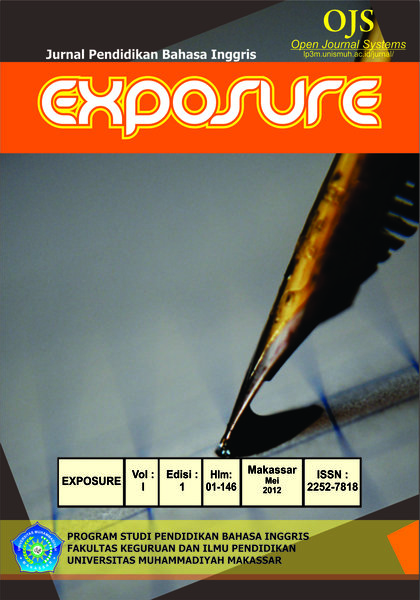THE USE OF TOMATIS METHOD TO IMPROVE STUDENTS’ LISTENING SKILL
DOI:
https://doi.org/10.26618/exposure.v1i1.766Abstrak
This research aimed to know the effectiveness of using Tomatis Method to improve the students’ listening skill and to know the student activeness toward teaching-learning process through Tomatis Method of the tenth-grade students of SMK Negeri 2 Makassar. The method of this research consisted of two cycles. One cycle consisted of four meetings. It means that there were eight meetings for two cycles. As a subject in this research was class X in the 2012-2013 academic year with students’ number as about 36 students, 23 of the students are men and 13 students are women. The instruments of this research were observation sheet and listening test or evaluation. The findings of the research were students’ improvement in listening was 64.55 in cycle I and then it became 73.93 in cycle II. The students’ participation in learning the listening process in the first meeting of the cycle I was 59.02% then it became 81.25% in the fourth meeting of cycle II.
Keywords: Tomatis Method, Listening, Improve.
Referensi
Anthony, E. M. (1963). Approach, method, and technique. English Language Teaching 17(2), 63-67
Azar, Betty Schrampfer 1941. Fundamentals of English Grammar-2ed. London
Bakhtin, M. M. 1986. Speech Genres and Other Late Essays: University of Texas Press.
Biber, D 2005. Student Grammar, London: Longman
Benefit music of education. Retrieved from http://www.classicsforkids.com/teachers/education/benefits.asp on July 25th, 2012
Bowen, Donald, J. 1985. TESOL Techniques and Procedures. London.
Brown, H. D. (1994) Principle of Language Learning and Teaching. 3rd ed. Englewood Cliff, NJ: Practice Hall Regents.
Bakken, Bjorg. 2006. English Grammar: An introduction for students of English as a foreign language. Bergen: Fagbokforlaget.
Buck, Gary 2001. Assessing Listening. Cambridge: Cambridge University Press
Bygate, M. 1997. Speaking. Oxford: Oxford University Press
Davies, S., 1994, Musical Meaning and Expression, Ithaca, NY: Cornell University Press.
Galvin, K 1985 Listening by doing. National Textbook Company Lincolnwood, Illinois, USA
Gay, L, R. (1981). Educational Research Competences for Analysis and Application.
Hasselgård, Hilde, Stig Johansson, and Per Lysvag. 1998. English Grammar: Theory and Use. Oslo: Universtets forlaget.
Howatt, A. and J. Dakin. 1974. Language Laboratory Materials, ed. J. P. B. Allen, S. P. B. Allen, and S. P. Corder.
Huddleston, R. & Pullum, G.K. (2002). The Cambridge grammar of the English. Cambridge University Press: UK.
James, Charles. J. 1984. Are You Listening? The Practical Component of Listening Comprehension. The University of Illinois. Chicago
Kivy, P., 1980, the Corded Shell: Reflections on Musical Expression, Princeton, NJ: Princeton University Press.
Pawley, A., & Syder, F. 1983. Two Puzzles for Linguistics Theory: native-like selection and native-like frequency. In J. Richard & R. Schmidt (Eds.), Language and communication. New York: Longman.
Research on Tomatis Method. Retrieved from http://www.atotalapproach.com/docs/tomatis.pdf on April 20th, 2012
Richard, J. and Rodger, T. 2001. Approaches and Method in Language Teaching. Cambridge: Cambridge University Press.
Rost, M. 1994. Introducing listening. London: Penguin
Sudjana. (1999). Metode Stastika. Bandung. PT Gramedia.
Sugayama and R. Hudson, editors. 2005. Word Grammar. New Perspectives on a Theory of Language Structure. Continuum, Kobe.
Underwood, Mary. 1989 Teaching Listening, Longman: New York
Unduhan
Diterbitkan
Terbitan
Bagian
Lisensi
Authors who publish with this journal agree to the following terms:
In order to assure the highest standards for published articles, a peer review policy is applied. In pursue of the compliance with academic standards, all parties involved in the publishing process (the authors, the editors and the editorial board and the reviewers) agree to meet the responsibilities stated below in accordance to the Journal publication ethics and malpractice statement.
Duties of Authors:
- The author(s) warrant that the submitted article is an original work, which has not been previously published, and that they have obtained an agreement from any co-author(s) prior to the manuscript’s submission;
- The author(s) should not submit articles describing essentially the same research to more than one journal;
- The authors(s) make certain that the manuscript meets the terms of the Manuscript Submission Guideline regarding appropriate academic citation and that no copyright infringement occurs;
- The authors(s) should inform the editors about any conflict of interests and report any errors they subsequently, discover in their manuscript.
Duties of Editors and the Editorial Board:
- The editors, together with the editorial board, are responsible for deciding upon the publication or rejection of the submitted manuscripts based only on their originality, significance, and relevance to the domains of the journal;
- The editors evaluate the manuscripts compliance with academic criteria, the domains of the journal and the guidelines;
- The editors must at all times respect the confidentiality of any information pertaining to the submitted manuscripts;
- The editors assign the review of each manuscript to two reviewers chosen according to their domains of expertise. The editors must take into account any conflict of interest reported by the authors and the reviewers.
- The editors must ensure that the comments and recommendations of the reviewers are sent to the author(s) in due time and that the manuscripts are returned to the editors, who take the final decision to publish them or not.
Authors are permitted and encouraged to post online a pre-publication manuscript (but not the Publisher’s final formatted PDF version of the Work) in institutional repositories or on their Websites prior to and during the submission process, as it can lead to productive exchanges, as well as earlier and greater citation of published work (see The Effect of Open Access). Any such posting made before acceptance and publication of the Work shall be updated upon publication to include a reference to the Publisher-assigned DOI (Digital Object Identifier) and a link to the online abstract for the final published Work in the Journal.

